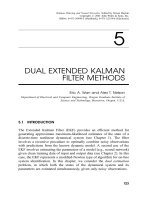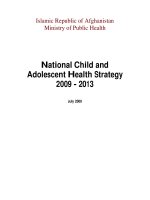child and adolescent counseling chapter 5
Bạn đang xem bản rút gọn của tài liệu. Xem và tải ngay bản đầy đủ của tài liệu tại đây (373.71 KB, 27 trang )
Chapter 5
Psychoanalytic Counseling
A moment’s insight is sometimes worth a life’s
experience.
Oliver Wendell Holmes
© 2011 Brooks/Cole, A
Chapter Objectives
After reading this chapter, you should be able to:
•Outline the development of psychoanalysis and Sigmund Freud
•Explain the theory of psychoanalysis including its core concepts
•Discuss the counseling relationship and goals in psychoanalysis
•Describe assessment, process, and techniques in psychoanalysis
•Demonstrate some therapeutic techniques
•Clarify the effectiveness of psychoanalysis
•Discuss psychoanalytic play therapy
© 2011 Brooks/Cole, A
Sigmund Freud
(1856-1939)
• Lived in Vienna for 80 years
• Noticed patients’ physical symptoms
seemed to have mental base
• He began to get the idea that most of the
forces at work were unconscious
• From this came the foundations for a theory
of personality
© 2011 Brooks/Cole, A
Sigmund Freud
• Developed his model of people over five
decades of observing and writing
• Major principles were based on the clinical
study of individual patients undergoing
treatment for their problems
• The father of psychoanalysis and the
grandfather of child psychoanalysis
© 2011 Brooks/Cole, A
Nature of People
• Psychic determinism and unconscious mental
processes
• People basically evil and victims of instincts that
must be balanced
• To achieve balance people need a deep
understanding of the forces that motivate them
• Psychic energy systems are the id, ego, superego
• Behavior determined by energy, unconscious
motives and by instinctual and biological drives
© 2011 Brooks/Cole, A
Basis
• Psychic determinism implies mental life is a
continuous logical manifestation of cause-related
relationships
• Unconscious mental processes are the causative
factors that are unknown, below conscious level
• Thus people often do not understand feelings or
actions
• Basis for much of what is involved in
psychoanalysis
© 2011 Brooks/Cole, A
Terms
•
•
•
•
•
Unconscious
Conscious
Preconscious
Subconscious
Collective unconscious
© 2011 Brooks/Cole, A
CONSCIOUSNESS
PRECONSCIOUS
THE PERSONAL
UNCONSCIOUS
SUBCONSCIOUS
THE COLLECTIVE
UNCONSCIOUS
© 2011 Brooks/Cole, A
Theory Concepts
Structural
o Id
o Ego
o Superego
Developmental
o Defense
mechanisms
o Psychosexual stages
Dynamic
o Instinct
o Cathexis
o Anticathexis
o Anxiety
© 2011 Brooks/Cole, A
Structural Concepts
• Id: basic instinctual drives and seeks
pleasure.
• Ego: attempts to balance the desires
of the id and the reality of the external
world.
• Superego: personal moral standard
© 2011 Brooks/Cole, A
Dynamic Concepts
• Instinct: inborn psychological representation
• Cathexis: directing energy toward an object
that will satisfy a need.
• Anticathexis: ego’s restraint of the id’s
impulses.
• Anxiety: conscious state that reflects the
presence of an emotional experience by
external or internal nervous energy.
© 2011 Brooks/Cole, A
Developmental Concepts
• Defense mechanisms: operations of the
mind that aim to ward off anxiety and
depression; unconscious distortions of reality
that reduce painful affect and conflict through
automatic, habitual responses
• Psychosexual Stages: succession of
stages characterized by dominant mode of
achieving libidinal pleasure and by specific
developmental tasks
© 2011 Brooks/Cole, A
LIBIDO
ENERGY SYSTEM
Involuntary
bodily
Involuntary
bodily processes:
© 2011
Brooks/Cole,
A processes:
Breathing,
digestion,
circulation
Breathing, digestion,
circulation
Defense Mechanisms
© 2011 Brooks/Cole, A
Psychosexual Stages
ORAL STAGE: Birth to 1 1/2 Years
o
Adjust to the weaning process and learn to chew food
ANAL STAGE: 1 1/2 to 3 Years
o
Regulation of natural functions
PHALLIC STAGE: 3 to 6 Years
o
o
Oedipus/Electra complex
Sexual desires and attitudes take shape
LATENCY STAGE: 6 to 11 Years
o
Developmental skills and activities
GENITAL STAGE: Adolescence
o
Developing heterosexual relationships
© 2011 Brooks/Cole, A
DEPENDENCY
AUTONOMY
© 2011 Brooks/Cole, A
When analyzing children
• Develop a warm, friendly relationship
• Accept the child
• Create an atmosphere of permissiveness in the
relationship
• Recognize the child’s feelings and reflect them
• Respect the child’s ability to solve problems
• Allow the child to lead and follow that lead
• Do not hurry
• Use only necessary limits (Merydith, 2007, p. 112).
© 2011 Brooks/Cole, A
Process: Beginning
• Opening phase
o reasons for seeking treatment
o triggers to current problems
o degree of distress of the client
• The elements of treatment
o building the therapeutic relationship
o exploring the client’s concerns
© 2011 Brooks/Cole, A
Process: Middle phase
• W orking through
o themes revisited and explored
o increase understanding of the forces, past patterns,
and inner conflicts that are causing the client’s
problems.
• The elements of treatment
o analysis of transference
o examination of other relationships
© 2011 Brooks/Cole, A
Process: Final phase
• Ending
o
goals have been reached
o
transference is resolved
o
separation is the next step
© 2011 Brooks/Cole, A
Psychoanalytic Counseling
and Self-Esteem
Simon’s six conditions for nurturing and
maintaining self esteem and mental health:
•Belonging
•Child Advocacy
•Risk Management
•Empowerment
•Uniqueness
•Productivity
© 2011 Brooks/Cole, A
Counseling Methods
CATHARSIS:
o Process of remembering, verbalizing, and emotionally reliving
an early childhood event in order to eliminate the symptoms
that had been caused by the event.
FREE ASSOCIATION:
o The process in which unconscious thoughts are brought to the
conscious mind by vocalizing whatever thoughts or feelings
come to mind.
INTERPRETATION:
o DREAMS - express wish fulfillment
o PARAPRAXIA - “Freudian Slips”
o HUMOR - Jokes, puns, satire are all acceptable means for
unconscious urges to gain access to the conscious.
© 2011 Brooks/Cole, A
Counseling Methods
ANALYSIS of TRANSFERENCE
o Client views the counselor as someone else
ANALYSIS of RESISTANCE
o Client resists the attempts of the counselor to help
ANALYSIS of INCOMPLETE SENTENCES
o Projective techniques to understand the client
BIBLIOCOUNSELING:
o Reading and discussing books about situations similar to
clients’ issues
© 2011 Brooks/Cole, A
Counseling Methods
STORYTELLING:
o
Client tells a story and the counselor retells
the story with better responses/alternatives
PSYCHOANALYTIC PLAY THERAPY
o
Toys and games assist the counselor with
putting the child at ease, creating an
alliance, and discovering clues about the
client’s inner life.
© 2011 Brooks/Cole, A
Psychoanalytic Play Therapy
Fundamental goal: the child’s insight into self
•aim is moving past the current pain in
order to accept one’s self and develop
security, adaptability, and self-accepting
ways
© 2011 Brooks/Cole, A









